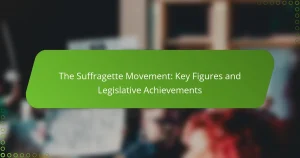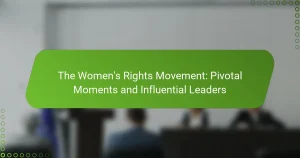The Civil Rights Movement was a crucial campaign aimed at achieving social justice and ending racial segregation and discrimination against African Americans in the United States. Key events from the 1950s to the 1970s, such as the Montgomery Bus Boycott and the March on Washington, played significant roles in advancing the movement. Influential leaders, particularly Martin Luther King Jr., promoted nonviolent protest, leading to landmark legislative achievements like the Civil Rights Act of 1964 and the Voting Rights Act of 1965. The movement evolved over time, addressing broader issues such as economic justice and police brutality, ultimately transforming American society and inspiring future social justice efforts.
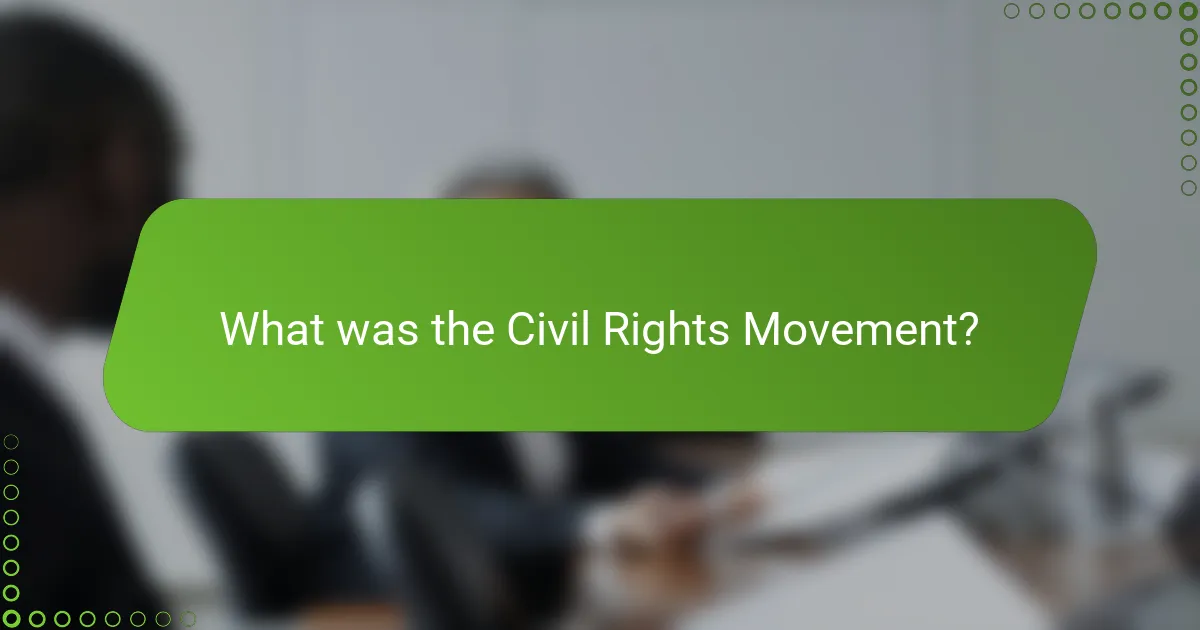
What was the Civil Rights Movement?
The Civil Rights Movement was a pivotal struggle for social justice in the United States. It aimed to end racial segregation and discrimination against African Americans. The movement gained momentum in the 1950s and 1960s. Key events included the Montgomery Bus Boycott in 1955 and the March on Washington in 1963. Leaders like Martin Luther King Jr. advocated for nonviolent protest. The Civil Rights Act of 1964 and the Voting Rights Act of 1965 were significant legislative achievements. These laws aimed to secure equal rights and protect voting access. The movement profoundly influenced American society and inspired future social justice efforts.
What were the key goals of the Civil Rights Movement?
The key goals of the Civil Rights Movement were to end racial segregation and discrimination against African Americans. This movement aimed to secure equal rights under the law. It sought to achieve voting rights for all citizens, particularly African Americans. The Civil Rights Movement also aimed to eliminate economic inequality and promote social justice. Landmark events, such as the March on Washington in 1963, highlighted these goals. The Civil Rights Act of 1964 and the Voting Rights Act of 1965 were significant legislative achievements. These laws aimed to dismantle institutional racism and ensure equal access to public facilities. The movement fundamentally transformed American society and its legal framework.
How did the movement aim to address racial inequality?
The Civil Rights Movement aimed to address racial inequality through nonviolent protests and legal challenges. Activists organized events such as the Montgomery Bus Boycott and the March on Washington. These actions sought to raise awareness of systemic racism and demand equal rights. Legal efforts included landmark cases like Brown v. Board of Education, which challenged segregation in schools. The movement also pushed for legislative changes, resulting in the Civil Rights Act of 1964 and the Voting Rights Act of 1965. These laws aimed to eliminate discrimination and protect voting rights for African Americans. The movement’s strategies combined grassroots activism with legal reform to create lasting social change.
What were the foundational principles of the Civil Rights Movement?
The foundational principles of the Civil Rights Movement included equality, justice, and nonviolent protest. Equality emphasized the belief that all individuals should have the same rights and opportunities, regardless of race. Justice focused on the legal and moral right to fair treatment and protection under the law. Nonviolent protest was a strategy employed to advocate for civil rights without resorting to violence, as exemplified by leaders like Martin Luther King Jr. These principles were rooted in the desire to dismantle systemic racism and segregation in American society, aiming for legislation such as the Civil Rights Act of 1964 and the Voting Rights Act of 1965.
What major events defined the Civil Rights Movement?
The Civil Rights Movement was defined by several major events. The 1954 Brown v. Board of Education decision declared racial segregation in public schools unconstitutional. The 1955 Montgomery Bus Boycott began after Rosa Parks was arrested for refusing to give up her seat. The 1963 March on Washington featured Martin Luther King Jr.’s iconic “I Have a Dream” speech. The 1964 Civil Rights Act prohibited discrimination based on race, color, religion, [censured], or national origin. The 1965 Voting Rights Act aimed to eliminate barriers to voting for African Americans. The Selma to Montgomery marches in 1965 highlighted the struggle for voting rights. Each event significantly advanced the cause of civil rights in the United States.
What was the significance of the Montgomery Bus Boycott?
The Montgomery Bus Boycott was significant as it marked a pivotal moment in the Civil Rights Movement. Initiated in December 1955, the boycott protested racial segregation on public buses in Montgomery, Alabama. It lasted for 381 days, demonstrating the power of collective action. The boycott led to a Supreme Court ruling that declared segregation on public buses unconstitutional. This event galvanized further civil rights activism across the United States. It also brought national attention to the struggle against racial injustice. Key figures, such as Martin Luther King Jr., emerged as leaders during this time. Overall, the boycott laid the groundwork for future civil rights advancements.
How did the March on Washington impact public perception?
The March on Washington significantly shifted public perception regarding civil rights. It showcased the unity and determination of the African American community. The event drew over 250,000 participants, highlighting widespread support for racial equality. Martin Luther King Jr.’s “I Have a Dream” speech resonated deeply, emphasizing the need for justice. Media coverage brought national attention to the civil rights struggle. This visibility helped to garner sympathy from many Americans. Polls indicated increased support for civil rights legislation post-March. Overall, the event solidified civil rights as a critical national issue.
What were the key figures in the Civil Rights Movement?
Key figures in the Civil Rights Movement include Martin Luther King Jr., Rosa Parks, Malcolm X, and John Lewis. Martin Luther King Jr. was a leader known for his nonviolent protests. He played a crucial role in events like the Montgomery Bus Boycott and the March on Washington in 1963. Rosa Parks is famous for her act of defiance by refusing to give up her bus seat, which sparked the Montgomery Bus Boycott. Malcolm X advocated for black empowerment and was a prominent figure in the Nation of [censured]. John Lewis was a key leader in the Student Nonviolent Coordinating Committee and played a significant role in the Selma to Montgomery marches. These individuals significantly shaped the movement and its impact on society.
Who was Martin Luther King Jr. and what role did he play?
Martin Luther King Jr. was an influential American civil rights leader. He played a pivotal role in the American civil rights movement from the mid-1950s until his assassination in 1968. King advocated for nonviolent protest to combat racial segregation and discrimination. He is best known for his leadership in the Montgomery Bus Boycott and the March on Washington in 1963. His famous “I Have a Dream” speech called for racial equality and justice. King’s efforts contributed to the passage of the Civil Rights Act of 1964 and the Voting Rights Act of 1965. His legacy continues to inspire movements for social justice worldwide.
What contributions did Rosa Parks make to the movement?
Rosa Parks made significant contributions to the Civil Rights Movement. She is best known for her act of defiance on December 1, 1955. Parks refused to give up her bus seat to a white passenger in Montgomery, Alabama. This act of resistance sparked the Montgomery Bus Boycott. The boycott lasted for 381 days and led to a Supreme Court ruling that declared segregation on public buses unconstitutional. Parks became a symbol of the struggle for civil rights. Her actions inspired many others to join the movement for racial equality. She worked alongside leaders like Martin Luther King Jr. to promote nonviolent protest. Parks’ contributions helped galvanize national attention toward the injustices faced by African Americans.
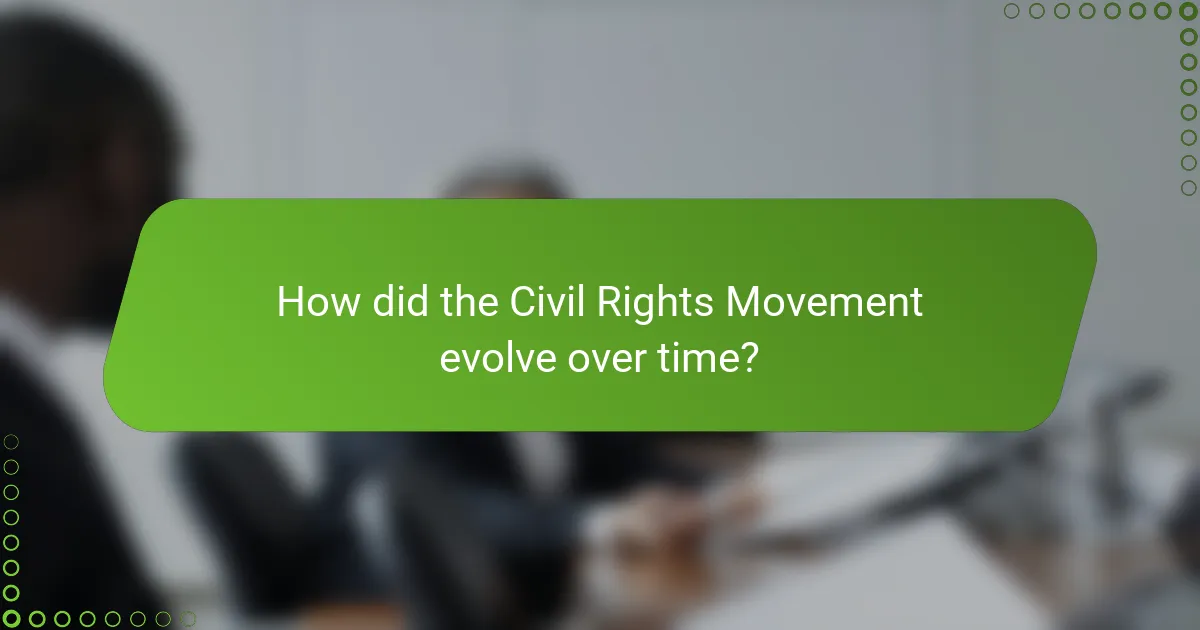
How did the Civil Rights Movement evolve over time?
The Civil Rights Movement evolved through distinct phases from the 1950s to the 1970s. Initially, it focused on legal challenges against segregation, exemplified by the 1954 Brown v. Board of Education decision. This ruling declared racial segregation in public schools unconstitutional, marking a pivotal victory.
In the 1960s, grassroots activism surged, highlighted by events like the 1963 March on Washington. This gathering showcased Martin Luther King Jr.’s “I Have a Dream” speech, emphasizing the demand for racial equality. Legislative achievements followed, including the Civil Rights Act of 1964 and the Voting Rights Act of 1965, which aimed to eliminate discrimination.
As the movement progressed, it diversified. Different groups emerged, advocating for broader issues, including economic justice and women’s rights. The late 1960s saw the rise of more militant factions, such as the Black Panther Party, which sought self-defense and community empowerment.
By the 1970s, the movement’s focus shifted towards addressing systemic issues, like poverty and police brutality. The evolution of the Civil Rights Movement reflects a response to changing social dynamics and the ongoing struggle for equality in America.
What were the major phases of the Civil Rights Movement?
The major phases of the Civil Rights Movement include the early activism phase, the legal phase, and the mass mobilization phase. The early activism phase occurred from the 1940s to the mid-1950s. During this time, organizations like the NAACP focused on legal challenges against segregation. Landmark cases, such as Brown v. Board of Education in 1954, declared school segregation unconstitutional.
The legal phase extended into the late 1950s and early 1960s. It involved significant legislation aimed at ending racial discrimination. The Civil Rights Act of 1964 and the Voting Rights Act of 1965 were pivotal laws that emerged during this period. These laws aimed to dismantle systemic racism and ensure voting rights for African Americans.
The mass mobilization phase peaked during the 1960s. This phase was characterized by widespread protests, sit-ins, and marches. The March on Washington in 1963, where Martin Luther King Jr. delivered his “I Have a Dream” speech, was a significant event. This phase aimed to raise awareness and demand immediate change for civil rights. Each phase built upon the previous one, contributing to the overall progress of the Civil Rights Movement.
How did the movement change from the 1950s to the 1970s?
The Civil Rights Movement evolved significantly from the 1950s to the 1970s. In the 1950s, the movement focused primarily on legal challenges and nonviolent protests against segregation. Landmark events included the Brown v. Board of Education decision in 1954, which declared school segregation unconstitutional. The Montgomery Bus Boycott in 1955 highlighted the effectiveness of organized, peaceful resistance.
By the 1960s, the movement expanded to include more aggressive tactics and a broader agenda. The Freedom Rides of 1961 aimed to desegregate interstate bus travel. Major legislation, such as the Civil Rights Act of 1964 and the Voting Rights Act of 1965, emerged during this period, addressing both discrimination and voting rights.
In the late 1960s, the movement began to encompass issues of economic justice and Black nationalism. Groups like the Black Panther Party advocated for self-defense and community empowerment. The assassination of key leaders, such as Martin Luther King Jr. in 1968, marked a turning point, leading to increased militancy in some factions.
Overall, the movement transitioned from a focus on legal integration to a broader struggle for social, economic, and political equality by the 1970s.
What role did grassroots organizations play in the movement’s evolution?
Grassroots organizations were crucial in the evolution of the Civil Rights Movement. They mobilized local communities and raised awareness about systemic injustices. Groups like the Student Nonviolent Coordinating Committee (SNCC) engaged young activists in direct action. They organized sit-ins, protests, and voter registration drives, which increased participation in the movement. Grassroots efforts highlighted issues like segregation and disenfranchisement. They also fostered leadership among ordinary citizens, empowering them to advocate for change. These organizations created a network of support that sustained the movement over time. Their grassroots strategies laid the foundation for larger national campaigns.
What were the reactions to the Civil Rights Movement?
The reactions to the Civil Rights Movement were diverse and polarized. Many Americans supported the movement, advocating for racial equality and justice. Significant protests, such as the March on Washington in 1963, drew massive crowds and garnered national attention. However, there was also substantial opposition from segregationists and some political leaders. Groups like the Ku Klux Klan used violence to intimidate activists. Law enforcement often responded with brutality against peaceful demonstrators. The Civil Rights Act of 1964 and the Voting Rights Act of 1965 were legislative responses to the movement’s demands. These laws aimed to eliminate legal discrimination, reflecting the movement’s impact on American society.
How did government policies respond to the movement’s demands?
Government policies responded to the Civil Rights Movement’s demands through legislative actions and executive orders. The Civil Rights Act of 1964 prohibited discrimination based on race, color, religion, [censured], or national origin. This landmark legislation was a direct response to the movement’s demand for equality. Additionally, the Voting Rights Act of 1965 aimed to eliminate barriers to voting for African Americans. This act addressed the systemic disenfranchisement highlighted by activists. The government also established the Equal Employment Opportunity Commission to enforce anti-discrimination laws. These policies reflected a significant shift towards recognizing and addressing civil rights issues. The response was influenced by widespread protests and public support for the movement’s goals.
What opposition did activists face during the Civil Rights Movement?
Activists during the Civil Rights Movement faced significant opposition from various entities. This opposition included violent resistance from white supremacist groups, such as the Ku Klux Klan. Law enforcement often collaborated with these groups, leading to arrests and brutality against peaceful protesters. Additionally, many politicians and government officials actively opposed civil rights legislation. Public sentiment in some regions also resisted desegregation and equal rights, resulting in widespread social unrest. Economic repercussions, including job loss and discrimination, further hindered activists’ efforts. Historical events, such as the Birmingham Campaign in 1963, exemplified the violent backlash activists encountered. These challenges underscored the systemic racism embedded in society at the time.
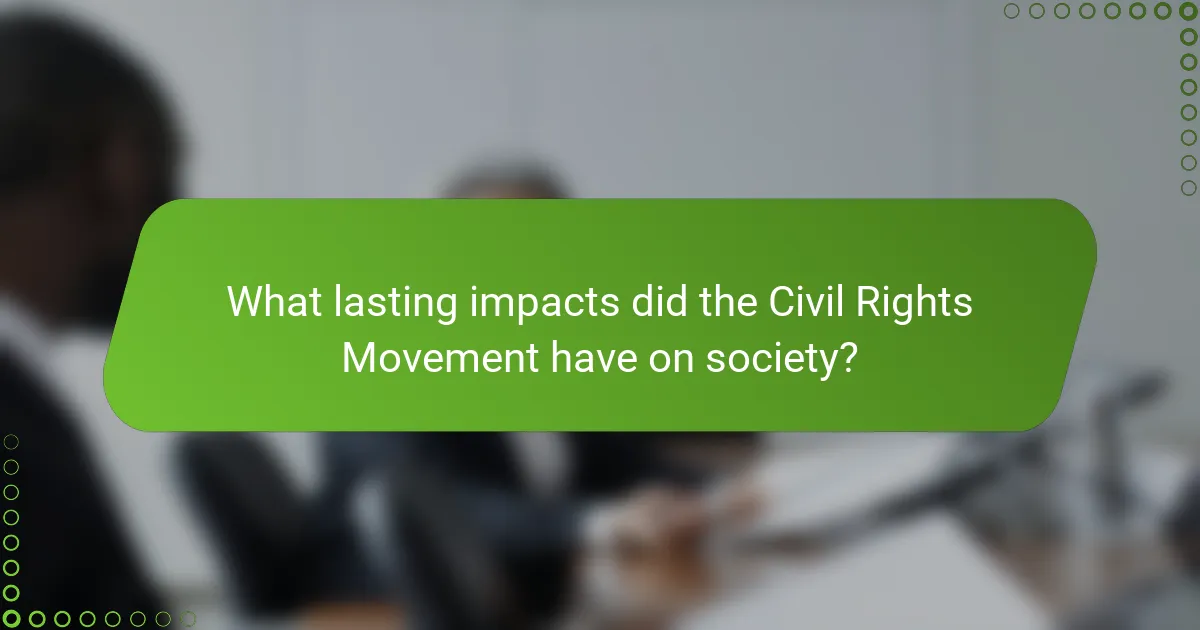
What lasting impacts did the Civil Rights Movement have on society?
The Civil Rights Movement significantly transformed American society. It led to the end of legal segregation through the Civil Rights Act of 1964. This legislation prohibited discrimination based on race, color, religion, [censured], or national origin. The Voting Rights Act of 1965 eliminated barriers to voting for African Americans. These changes increased political representation and participation among minority groups. Social attitudes towards race began to shift, promoting greater acceptance and equality. Educational access improved, leading to increased opportunities for African Americans. The movement also inspired other social justice movements, creating a legacy of activism. Overall, the Civil Rights Movement laid the foundation for ongoing struggles for equality and justice in the United States.
How did the movement influence legislation in the United States?
The Civil Rights Movement significantly influenced legislation in the United States. It led to the enactment of key laws aimed at ending racial discrimination. The Civil Rights Act of 1964 prohibited discrimination based on race, color, religion, [censured], or national origin. This landmark legislation was a direct response to the movement’s activism and protests. The Voting Rights Act of 1965 aimed to eliminate barriers preventing African Americans from voting. These laws were influenced by widespread demonstrations, such as the March on Washington in 1963. The movement’s efforts raised public awareness and support for civil rights issues. This culminated in legislative changes that aimed to promote equality and justice.
What key laws emerged as a result of the Civil Rights Movement?
The key laws that emerged as a result of the Civil Rights Movement include the Civil Rights Act of 1964 and the Voting Rights Act of 1965. The Civil Rights Act of 1964 prohibited discrimination based on race, color, religion, [censured], or national origin. This law aimed to end segregation in schools, workplaces, and public accommodations. The Voting Rights Act of 1965 aimed to eliminate barriers to voting for African Americans. This act outlawed discriminatory voting practices, such as literacy tests. Both laws were significant milestones in the fight for civil rights and equality in the United States.
How did the movement shape future civil rights efforts?
The Civil Rights Movement significantly influenced future civil rights efforts by establishing foundational strategies and frameworks. It emphasized nonviolent protest as an effective means of advocating for change. Landmark legislation, such as the Civil Rights Act of 1964, set legal precedents that future movements could leverage. The movement also inspired subsequent social justice campaigns, including those for women’s rights and [censured] rights. Activists learned the importance of grassroots organizing and coalition-building, which became crucial for later efforts. The media coverage of the movement highlighted the power of public awareness in driving legislative change. Overall, the Civil Rights Movement laid the groundwork for ongoing struggles for equality and justice in America.
What cultural changes resulted from the Civil Rights Movement?
The Civil Rights Movement led to significant cultural changes in American society. It fostered greater awareness of racial inequality and injustice. This movement inspired a sense of solidarity among marginalized groups. It also influenced art, music, and literature, promoting themes of freedom and equality. The movement resulted in the integration of public spaces and schools. It encouraged the celebration of African American culture and history. Civil Rights activists became cultural icons, shaping public discourse. Overall, the Civil Rights Movement transformed societal values towards inclusivity and justice.
How did the movement affect the arts and media representation?
The Civil Rights Movement significantly influenced arts and media representation. Artists and filmmakers began to highlight racial injustices and the struggle for equality. This led to a surge in works that depicted African American experiences authentically. For instance, the 1960s saw the rise of protest songs that became anthems for the movement. Notable figures like Nina Simone and Sam Cooke used their platforms to address social issues. Additionally, television shows and films started featuring African American characters in more nuanced roles. This shift challenged stereotypes and broadened public perception. The movement’s impact on media continues to resonate today, shaping narratives around race and identity.
What role did education play in promoting civil rights awareness?
Education played a crucial role in promoting civil rights awareness. It served as a platform for disseminating information about social injustices. Schools and universities became hubs for activism and discussion. Notable figures, such as Martin Luther King Jr., emphasized the importance of education in fostering equality. The integration of schools highlighted racial disparities and mobilized communities. Educational programs raised awareness of civil rights issues through curricula focused on history and social justice. Landmark events, like the Brown v. Board of Education decision in 1954, underscored the need for equitable education. These efforts contributed to a more informed public and greater advocacy for civil rights reform.
What lessons can be learned from the Civil Rights Movement today?
The Civil Rights Movement teaches the importance of activism and collective action. It emphasizes that sustained efforts can lead to significant social change. Nonviolent protest strategies, like those used by Martin Luther King Jr., remain effective today. The movement highlights the necessity of legal reforms to ensure equality. Legislative successes, such as the Civil Rights Act of 1964, demonstrate the impact of policy changes. It also showcases the power of grassroots organizing in mobilizing communities. The movement’s legacy encourages ongoing dialogue about race and justice. Additionally, it illustrates the need for allyship across diverse groups to achieve common goals.
How can modern movements draw inspiration from the Civil Rights Movement?
Modern movements can draw inspiration from the Civil Rights Movement by adopting its strategies of nonviolent protest and grassroots organizing. Nonviolent tactics, like sit-ins and marches, effectively mobilized public support and garnered media attention during the Civil Rights Movement. For instance, the 1963 March on Washington drew over 250,000 participants, showcasing the power of collective action. Grassroots organizing was pivotal in building community coalitions and fostering local leadership. Organizations like the Student Nonviolent Coordinating Committee (SNCC) exemplified this approach by empowering youth and local activists. Additionally, the use of social media today mirrors the dissemination of information and mobilization efforts seen in the Civil Rights Movement. Hashtags and online campaigns can amplify messages and reach wider audiences quickly. By studying these methods, modern movements can enhance their effectiveness in advocating for social justice.
What strategies can be employed to continue the fight for equality?
Advocating for policy changes is a key strategy to continue the fight for equality. This involves lobbying for laws that protect civil rights. Engaging in grassroots organizing mobilizes communities to demand change. Education and awareness campaigns inform the public about equality issues. Collaborating with diverse organizations strengthens the movement. Utilizing social media amplifies voices and reaches wider audiences. Legal challenges can address injustices in courts. Historical examples show that persistent advocacy leads to significant reforms, such as the Civil Rights Act of 1964.
The Civil Rights Movement was a crucial struggle for social justice in the United States, aimed at ending racial segregation and discrimination against African Americans, particularly during the 1950s and 1960s. Key events such as the Montgomery Bus Boycott and the March on Washington, along with influential leaders like Martin Luther King Jr. and Rosa Parks, played significant roles in advancing the movement’s goals. The movement led to landmark legislation, including the Civil Rights Act of 1964 and the Voting Rights Act of 1965, which sought to secure equal rights and voting access. This article will explore the major events, foundational principles, key figures, and lasting impacts of the Civil Rights Movement on American society.


